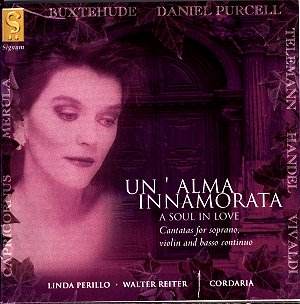|
The programme on this CD consists of music for
voice and violin from the 17th and 18th centuries. In the 17th century,
in particular in Italy, the violin was considered the most expressive
instrument. Numerous sonatas, capriccios, sinfonias and canzonas
were written for the violin. And it was also thought to be able
to imitate the human voice (alongside the cornet). Therefore it
is no surprise that many composers wrote pieces for solo voice and
violin with basso continuo. Voice and violin were treated equally:
the violin isn’t merely ‘accompanying’ the voice. In the 18th century
the violin had to compete with other instruments.
Telemann is a good example of a composer who paid
almost equal attention to all kinds of instruments: his collection
‘Harmonischer Gottesdienst’ contains cantatas for solo voice with
one melody instrument: violin, but also recorder, transverse flute
and oboe. And although Vivaldi was a virtuoso violinist, he composed
only one cantata for voice and violin, the one recorded here. Composers
used the combination of voice and violin to achieve a maximum of
expression. Unfortunately that is not what this recording delivers.
Linda Perillo has a nice voice, crisp and clear,
without a ‘wobble’. She is at her best in more introverted passages,
like the middle section of the sacred concerto by Capricornus.
Sample track 1
She clearly tries to express the emotions in the
recitatives of the secular cantatas by Vivaldi and Handel, but the
range of her possibilities seems too limited. There is a lack of
dynamic contrast and her articulation isn’t very clear. The pronunciation
of the German texts is anything but perfect and her Italian doesn’t
sound very natural to me – as far as I, being non-Italian, can tell.
There is a general lack of contrast in the ensemble
playing. In Buxtehude’s cantata the contrast between the first line
– "Singet dem Herrn ein neues Lied" (Sing unto the Lord
a new song) – and the second – "denn er macht Wunder"
(for he has done marvellous things) – sounds far too harmless.
Sample track 3
Walter Reiter's playing isn’t very colourful and
is somewhat one-dimensional. Most of the time he plays legato, without
a clear distinction between important and less important notes –
‘good’ notes and ‘bad’ notes, as they were called in the 18th century.
There is a general lack of drama in this recording:
everything sounds nice and neat, but there is no excitement whatsoever.
Sample track 9
The recording technique doesn’t help: the sound
is a little flat and the volume is on the low side.
I am afraid one sentence in the booklet illustrates
what is missing here. Brian Clark writes that in the cantata by
Telemann the two arias are separated by a "somewhat declamatory"
recitative, as if that is something very peculiar. But basically
all baroque music – vocal or instrumental – is ‘declamatory’. If
the musicians had realised this, the result would have been a lot
better.
Johan van Veen
|

